
News
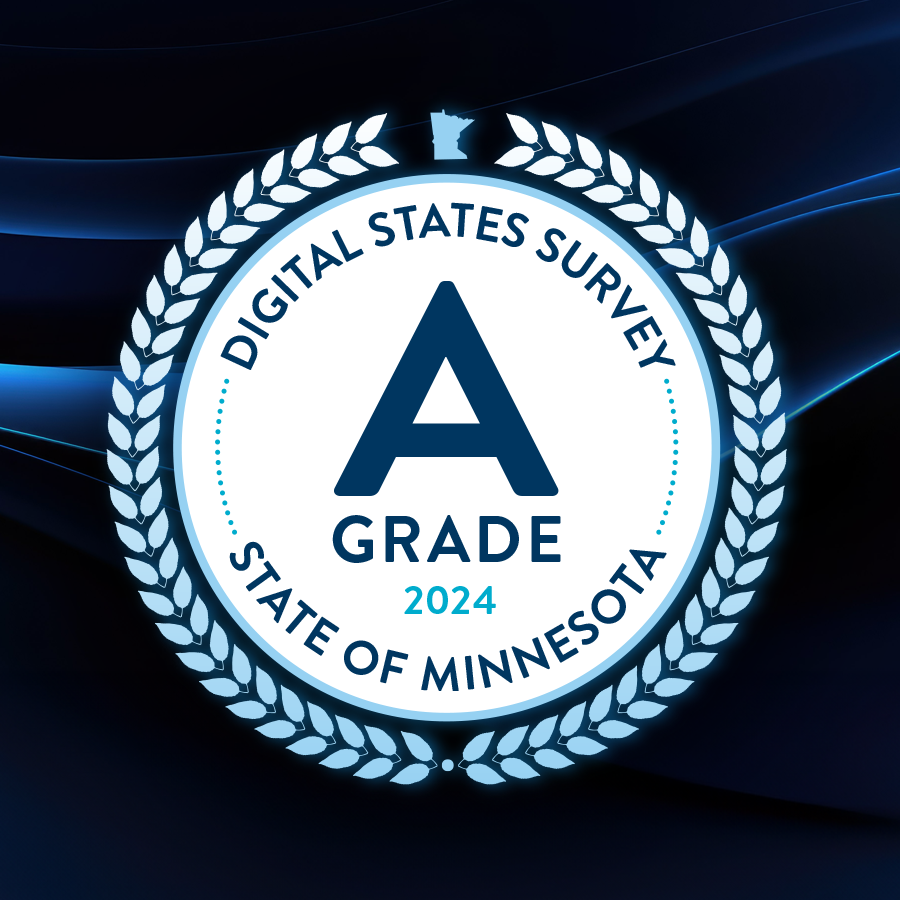
Minnesota achieves “A” rating from Digital States Survey
The Center for Digital Government awarded Minnesota an “A” in the 2024 Digital States Survey, the highest grade for its use of digital technology.
Minnesota’s recognition reflects its commitment to delivering top government services through innovative technology. As one of nine states to receive an “A,” Minnesota was recognized for its innovation, high-performing technology, and best practices in operations, governance, and administration.
Minnesota IT Services (MNIT), aligned with the One Minnesota Plan, prioritizes technology to make Minnesota a better place to live, work, and raise a family. The state’s leadership was further highlighted with a first-place award in the Continuous Innovation category, recognizing its use of emerging technologies to improve services.
The Digital States Survey benchmarks state technology use in service delivery, capacity building, and policy achievement. Minnesota was honored at the National Association of State Chief Information Officers Annual Conference in New Orleans, LA, on Oct. 2.
MNIT Green Team wins Sustainable Achievement Award
The MNIT Green Team received the prestigious Sustainability Achievement Award for its outstanding work in sustainable procurement. This award, presented by the Enterprise Sustainability Steering Team and chaired by Lt. Gov. Peggy Flanagan, recognizes exceptional sustainability initiatives across state agencies. MNIT’s Green Team was honored for their comprehensive approach to reducing solid waste and enhancing recycling efforts.
Key initiatives included documenting and communicating changes in waste and recycling procedures, collaborating with vendors to shift to multi-pack and reusable containers, and promoting bulk packaging to minimize waste. These efforts significantly reduced packaging material, lowered emissions, and increased efficiency in both shipping and internal operations. By mandating these sustainable practices in future contracts, MNIT is setting a new standard for environmentally conscious procurement.
The Green Team’s initiatives contribute to a cleaner, healthier Minnesota by reducing waste and emissions, benefiting the environment and local communities. This award highlights MNIT’s leadership in sustainability and aims to inspire other agencies to adopt similar practices. MNIT remains committed to continuing its journey toward environmental stewardship, and this recognition reflects the dedication of all involved in driving positive change for the future of Minnesota.
MNIT Week
In September, MNIT hosted its annual MNIT Week, packed with professional development and chances for staff to connect with one another and leadership. Highlights included an all-staff meeting, a service milestone ceremony, and the agency’s Annual Awards.
Annual Awards
On Friday, Sept. 20, MNIT held its Annual Awards ceremony to recognize service excellence and the honorees’ dedication to furthering MNIT’s mission, vision, values, and priorities. Learn more about this year’s finalists and honorees.

Ted Goessling selected as the agency’s first AI Director

MNIT announced the selection of Ted Goessling as its first Director of Artificial Intelligence (AI). With nearly 15 years at MNIT, Ted has established himself as a leader in the responsible use of AI.
In this new role, Ted will collaborate with MNIT and state agencies to create ethical governance frameworks for AI tools. His background includes various positions, such as Product Manager and Systems Architect, where he has developed AI business use cases and impact analysis frameworks.
As the leader of the Transparent Artificial Intelligence Governance Alliance (TAIGA), Ted and the team implemented the state’s first Public AI Services Security Standard and organized workshops to enhance AI usage among state employees.
MNIT recognized for One Minnesota Implementation efforts
Over the past year, state agencies have diligently worked to realize the vision of the historic 2023 One Minnesota Budget. On September 17, the Governor’s Office hosted the One Minnesota Implementation Champion Awards to celebrate these achievements and recognize the individuals and teams driving our success. Colleagues from across the state enterprise were honored as champions of implementation, equity, community engagement, evaluation, technology, innovation, enterprise-wide support, and collaboration.
The Minnesota Geospatial Information Office (MnGeo) and the Office of Cannabis Management received recognition for their partnership on the Social Equity Applicant Map. Additionally, MNIT was a finalist for its efforts in cybersecurity and customer experience.
Furthermore, technology and MNIT teams played a pivotal role in many award-winning projects, including the launch of the Department of Children, Youth, and Family (DCYF) and the establishment of the Enterprise Translations Office services.
 Governor Walz speaks at Esri User Conference about Minnesota’s use of geospatial data
Governor Walz speaks at Esri User Conference about Minnesota’s use of geospatial data
Governor Tim Walz spoke at the Esri User Conference in July, where he highlighted Minnesota’s efforts to use geospatial technology in advancing sustainable development and social equity. His address emphasized how mapping technologies are critical to initiatives like peatland conservation and poverty reduction through policies such as child tax credits and universal free meals. Walz also connected the role of data-driven governance in shaping land use decisions, environmental protection, and social justice, particularly for historically marginalized communities.
Walz’s address underscored Minnesota’s commitment to equity and the vital role geospatial professionals play in realizing this vision. Watch the address via the Esri website.
Product and project highlights
Help Me Grow language enhancements
As a direct impact of community and family feedback, MNIT teams worked with the Minnesota Department of Education’s (MDE’s) Early Childhood Special Education team to provide Help Me Grow Minnesota referral forms in Hmong, Somali, and Spanish. Before this, parents, guardians, and professionals who use these languages faced barriers when trying to connect their infants, toddlers, and young children with early developmental supports and services due to English-only forms. Many families and providers had to request help completing the forms, delaying this critical connection for children and families, or missed out entirely because the forms weren’t available in their languages.
By creating the Parents & Guardians, Professionals, and Friends & Family forms in Hmong, Spanish, and Somali, families can quickly request help when they want and need it. The translated forms include clearer, family-supportive language and better explanations of the information needed, along with email fields to reduce delays and align with changing communication preferences. This removes a barrier to the referral process and ensures timely responses from families’ local district and cooperative programs, as well as better supporting these programs and the state in meeting federal and state requirements.
MNIT’s work ensures that children and families who speak Hmong, Spanish, and Somali – and from the 11 Tribal Nations – can access critical development support for their infants, toddlers, and young children. This support can have a life-changing impact on each child and family.

Fall Color Finder map improvements
Every fall, Minnesotans and visitors anticipate the vibrant transformation of the state’s landscape. To aid in exploring this seasonal beauty, the Department of Natural Resources (DNR) Fall Color Finder helps track peak foliage across Minnesota. This year, MNIT partnered with DNR’s Parks and Trails Division to enhance the tool, focusing on accessibility and user experience.
These enhancements ensure the DNR Fall Color Finder provides a more engaging, accessible experience, supporting users in planning their autumn adventures.

Key updates
- Improved navigation: A redesigned, responsive interface adapts seamlessly to smartphones, tablets, and desktops. The “Latest Conditions” section now displays a grid with updates for all parks, making it easier to view information at a glance.
- Enhanced forecasting: New features allow users to compare fall color data from non-consecutive years, informed by historical data since 2013, to better anticipate peak times.
- User contributions: An updated photo submission system lets users easily upload images with pre-set tags. Interactive park markers now show recent photos and conditions, reducing staff workload and adding real-time visual updates.
Risk assessment improvements
The Minnesota Department of Corrections (DOC) has taken a person-centered approach to help individuals in their rehabilitation and reintegration journeys. By recognizing each person’s unique needs, circumstances, and goals, DOC tailors programs and services to support their growth and well-being. This aligns with DOC’s mission to transform lives for a safer Minnesota.
To make facilities and communities safer, DOC, in partnership with MNIT, introduced a new risk assessment tool. The tool gives a comprehensive understanding of each individual, including their potential risk to others. This new tool, built into the Corrections Operations Management System (COMS), allows caseworkers to assess potential risk and tailor support at intake and every six months. By empowering DOC staff to make better-informed programming decisions matched to individual needs, this tool enhances safety for both staff and incarcerated individuals.
Through this partnership, DOC and MNIT demonstrate their commitment to delivering person-centered technology solutions that support the One Minnesota Plan.
MnDOT tort claims
The Minnesota Department of Transportation’s (MnDOT’s) Tort Claims Office partnered with MNIT to transform the tort claims process by automating it and creating a customer-facing online portal. Claimants can now file claims digitally, upload supporting documents, and track submissions without the hassle of printing forms or visiting an office. This streamlined process enhances convenience, improves communication, and speeds up the approval or denial of claims.
With the new system, claimants simply fill out an online form, sign it electronically, and upload any additional materials. They receive immediate confirmation, while the Tort Claims team is instantly notified of new claims, enabling faster processing.
MnDOT and MNIT worked closely to identify project needs and implement the solution, which also empowers MnDOT to troubleshoot issues internally, reducing reliance on MNIT and improving overall efficiency. This collaborative effort has not only transformed the claimant experience but also optimized operations between state agencies.
Coordinating the protection of vulnerable adults
The Minnesota Adult Abuse Reporting Center (MAARC) serves as the centralized statewide platform for mandated reporters and the public to report suspected abuse, neglect, or financial exploitation of vulnerable adults. MAARC operates a 24/7 toll-free hotline for public use and offers an online reporting option for mandated reporters. Each reported incident is directed to the appropriate local agencies responsible for the vulnerable adult’s location and situation, including local law enforcement if the report suggests potential criminal activity.
To aid in identifying the location of the vulnerable adult and incident, the call center uses a web-based mapping application provided by MnGeo. This tool allows MAARC users to input an address, city, county, or landmark, mapping the location and returning contact information for relevant referral agencies. This feature equips users with immediate access to local adult protection and law enforcement contacts, streamlining what would otherwise require navigating various external resources.
Under Minnesota Statute 626.557 Subd. 9a, MAARC must promptly refer vulnerable adults to a county adult protection program when emergency services are needed and immediately notify law enforcement when incidents may be criminal. The mapping services facilitate timely protection and ensure compliance with mandated response protocols.
Modernization Maturity Assessment
The Modernization Playbook provides a customer-centric service delivery framework to enable MNIT and its partner agencies to deliver value and meaningful outcomes to Minnesotans who use their services or are impacted by their initiatives. Since 2020, every two years, MNIT at agencies and their business partners, using the Modernization Maturity Assessment (MMA), collaborate to measure agency maturity levels against the Playbook recommendations on a 0 to 5 scale.
In 2024, the aggregated assessment results from 20 agencies showed an 11% improvement from 2022, with the average maturity rising from 2.7 to 3.0, indicating that agencies generally have established processes guiding their activities; they will now focus on identifying improvement areas and implementing actions with support from the Transformation Office.
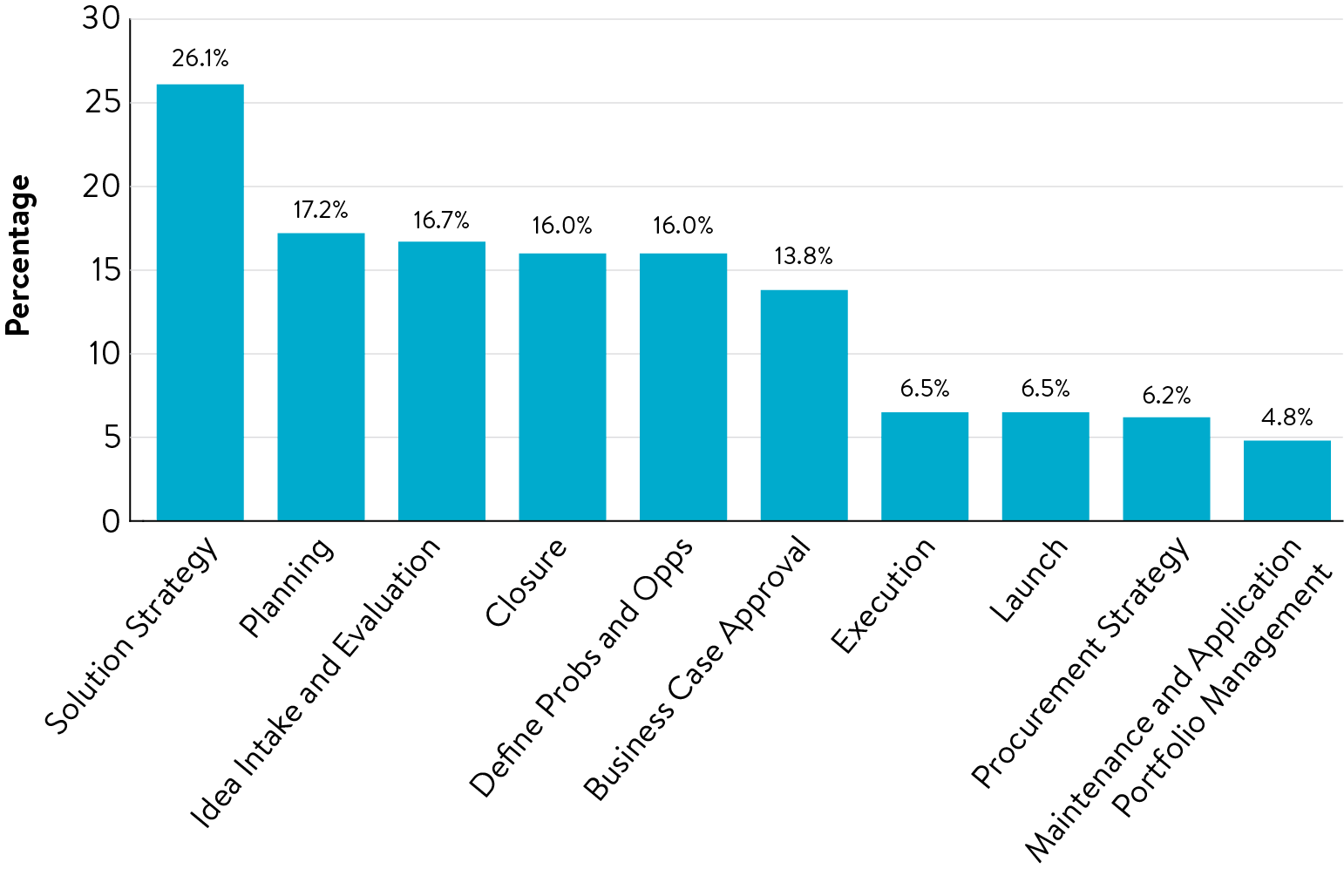
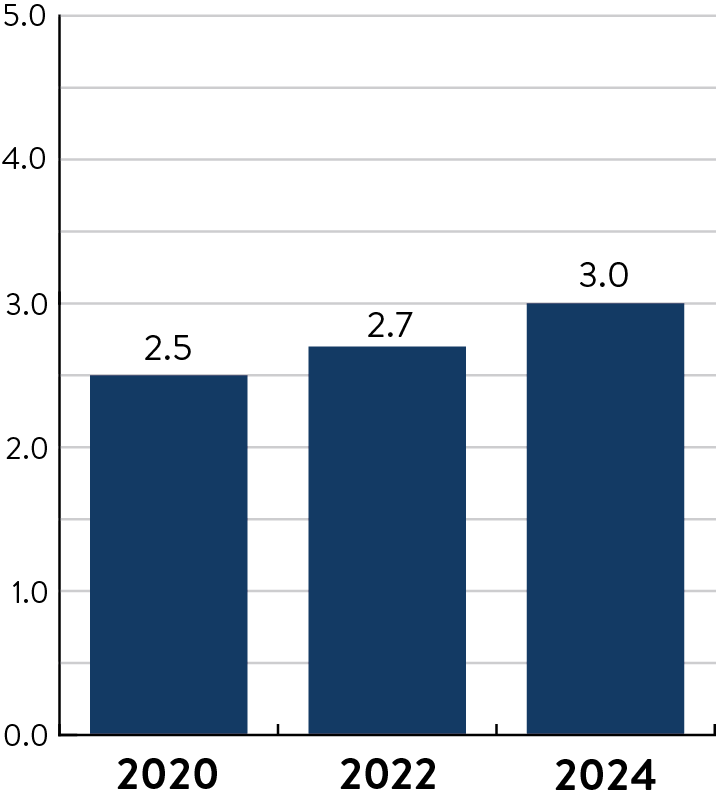
Security updates
Quick, unified response to CrowdStrike event
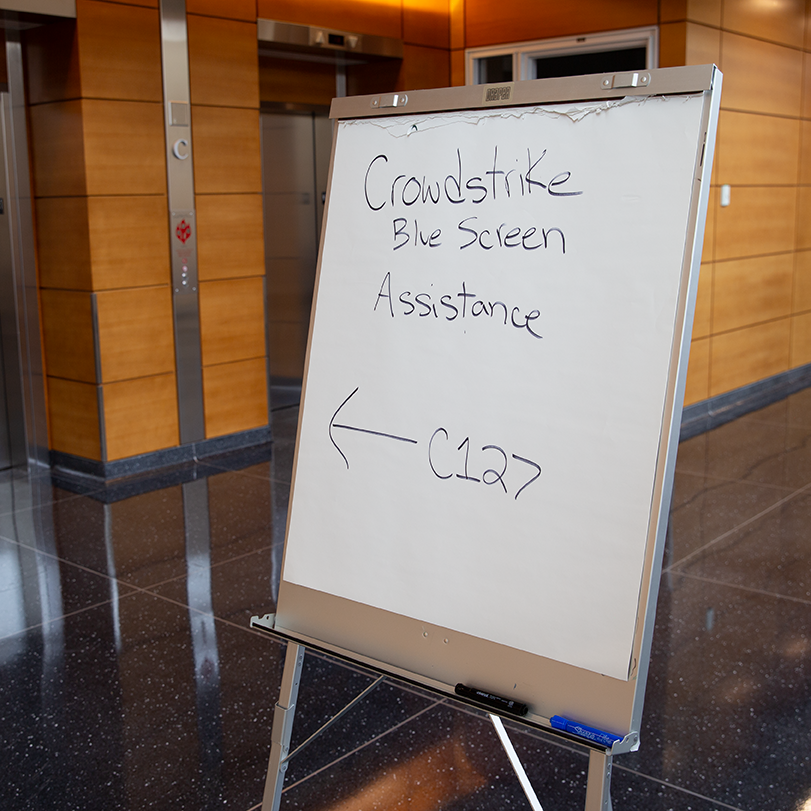
In the early hours of Friday, July 19, 2024, a global IT outage from cybersecurity vendor CrowdStrike affected systems across Minnesota. This impacted State of Minnesota systems, including call centers, state applications, websites, networks, and more. MNIT responded quickly, first focusing on restoring services to the most critical systems and applications in the state, and collaborating with agency partners and vendor partners to identify and fix the issues.
By 7 p.m. on July 19, most systems were restored. MNIT teams continued working through the weekend to bring the remaining servers and applications back online.
To support state employees with device issues, MNIT expanded virtual and in-person support options statewide. Many agency partners and employees shared that they appreciated the easy access to MNIT team members. Most employees recognized this was a global event outside of MNIT’s control and appreciated the support MNIT provided in person and virtually to bring the right resources to the table and keep state business running smoothly.
Since then, MNIT has completed internal after-action reviews to apply the lessons learned from this event, helping strengthen our response and recovery strategies for MNIT partners statewide.
Cybersecurity incident report form available online
As cyber-attacks increasingly evolve and continually target local governments and schools, Minnesota can benefit from improved information sharing. MNIT and the Bureau of Criminal Apprehension (BCA) collaborated with local government partners to create a secure, user-friendly cybersecurity incident report form and detailed instructions, as outlined in section 16E.36 of the Public Safety and Judiciary Omnibus law. MNIT and the BCA launched the form and instructions on Sept. 30 at mn.gov/mnit/cir.
The MNIT website includes:
- A cybersecurity incident report online form.
- Instructions and guidance to complete the reporting form.
- A list of entities required to report a cybersecurity incident.
- Types of cybersecurity incidents to report.
- When and how to report a cybersecurity incident.
- Other options for reporting if the online form is inaccessible.
Beginning Dec. 1, 2024, state law requires public agencies – local governments, public K-12 and higher education institutions, and government contractors – to use this online form to report cybersecurity incidents that impact their respective entity.
Reporting cybersecurity incidents to one source in a timely and consistent manner will allow MNIT and the BCA to better respond to emergencies and improve their ability to share security information and communication statewide. While information provided on the cybersecurity incident report form is private under state law, MNIT and BCA may share anonymized threat advisories or general cybersecurity guidance with local governments to help reduce risk and defend against cybersecurity threats.
The power of collaboration with Metro State University
Following MNIT’s partnership with Metro State University (MSU) on a security risk assessment pilot program in early 2024, the White House Office of the National Cyber Director (ONCD) expressed interest in convening key stakeholders for a roundtable discussion on cybersecurity. The White House ONCD was enthusiastic about the work of MSU’s Cybersecurity Clinic and their collaboration with MNIT.
Metro State coordinated a Cybersecurity Workforce Roundtable on Sept. 24, 2024, with ONCD’s Harry Wingo, Deputy National Cyber Director, as well as Metro State representatives, and MNIT Commissioner Tarek Tomes. The event was designed to develop a forward-looking vision to strengthen Minnesota’s cyber workforce, including federal, state, and local perspectives.
During the event, Commissioner Tomes spoke about “The Power of Collaboration” within the cybersecurity landscape. He highlighted the security risk assessment pilot program that MNIT’s Whole-of-State Cybersecurity team partnered on with Metro State in early 2024. The program provided low-cost, cybersecurity risk assessments at a professional level to local governments and K-12 schools.
Through this collaboration, the program created a mentorship environment for students, where they could learn from experienced MNIT professionals and security subject matter experts, improve their confidence and capabilities, and apply their academic knowledge to gain practical experience.
Following the pilot program, MSU and MNIT recognized the need for scalability and determined a need for some degree of automation and/or alternative solutions. MNIT’s team is meeting with other states to understand how to best scale this project and is identifying additional partners that can provide added value to deliver assessments to Minnesota entities most in need.
Through the MNIT-MSU collaboration, MNIT supported the development of the next generation of cybersecurity professionals and hired at least one of the MSU students as a MNIT Security Operations Center student worker. In addition, the program strengthened relationships between all participants to address cybersecurity challenges, and delivered value to local governments, students, and the broader community that no one organization could have provided alone.
Partnering with Minnesota National Guard
MNIT values its partnership with the Minnesota National Guard, who supports MNIT’s plan to mitigate cyber risks statewide. Together, we partner to better support local governments when a cyber incident occurs. In peace time, we focus on planning and coordination, so when a crisis happens, we have experts who can assist.
The Minnesota National Guard Cyber Coordination Cell (C3) organized the first Minnesota Military Cyber Symposium on Aug. 3 at Metro State University. More than 100 attendees heard from top experts, including MNIT’s Assistant Commissioner and Chief Information Security Officer John Israel, on building a stronger partnership. The assistant commissioner highlighted the ongoing partnership MNIT has with the National Guard, and how the National Guard fits into the Minnesota Whole-of- State Cybersecurity Plan.
The National Guard launched its C3 in October 2023, and four state active-duty members now coordinate cybersecurity support between MNIT, National Guard resources, and local governments. A National Guard representative, who is dedicated to the Whole-of-State Plan, works with MNIT to solve problems per the C3 proactive objectives.
Our next steps are to identify resources needed to prevent and defend against cyber threats; enhance our relationship to collectively support and bolster cybersecurity efforts to protect Minnesotans; study other state examples of state/National Guard partnerships; access peace-time resources to help assess and consult; and develop incident consultation and expert help.

Whole-of-State Cybersecurity Plan expands services
Entities can strengthen their own cyber defenses while boosting cyber resiliency across Minnesota when they participate in the Whole-of-State Cybersecurity Plan. Based on feedback from local entities participating in the Whole-of-State Cybersecurity Plan, MNIT expanded the security services it provides to local governments to include vulnerability management, which will help them strengthen and secure their cybersecurity defenses.
In addition to providing Managed Detection and Response (MDR) as a service, MNIT now offers:
- Internal Vulnerability Management Service (IVMS): Enterprise-class vulnerability tools use scanning technology to identify, assess, prioritize, and remediate security vulnerabilities. This service is available to Minnesota counties, port cities, and Tribal Nations.
- External Vulnerability Management Service (EVMS): A combination of attack-surface management and vulnerability scanning tools perform external scans to assess an entity’s threat and vulnerability posture from an outside perspective. This service is available to Minnesota counties and executive branch agencies.
- MDR, a 24/7 solution that looks for and blocks the types of attacks that could lead to data breaches, ransomware, or other major events, is available to all eligible local government entities in Minnesota, including counties, cities, townships, K-12 school districts, and Tribal Nations.
These three sophisticated services are available at a subsidized cost through grant funding, making them affordable and accessible. MNIT meets every organization where it is at, and MNIT’s Cyber Navigator team works with entities to help them advance stronger, sustainable cybersecurity tools.
MNIT names Whole-of-State Cybersecurity Team as Team of the Year
MNIT hosted our Annual Awards ceremony on Sept. 20. The Annual Awards brought MNIT employees together to recognize the exceptional individuals, teams, and projects that have significantly impacted our mission to serve the people of Minnesota. This event offers a chance to learn from each other’s successes, and reflect on and celebrate the hard work, dedication, and innovation that bring us closer to a more secure, digital government.
The Whole-of-State Cybersecurity Team was named this year’s Team of the Year for their comprehensive efforts in protecting Minnesota’s digital infrastructure. The Team of the Year award honors an operational team that provides outstanding, customer-focused service while supporting an existing product or service.
Through the rollout of the Whole-of-State Cybersecurity Plan, the team achieved a 30% reduction in critical vulnerabilities statewide. Their collaborative approach involved risk assessments for local governments and partnerships with institutions like Metro State University. By securing new federal funding and fostering collaboration with over 500 statewide entities, the team has made Minnesota a leader in cybersecurity, with a significant impact on both local government agencies and K-12 public schools. Finalists for the 2024 Team of the Year included MNIT’s Communications Team, SSIS Operations Team, and Threat and Vulnerability Management Team.
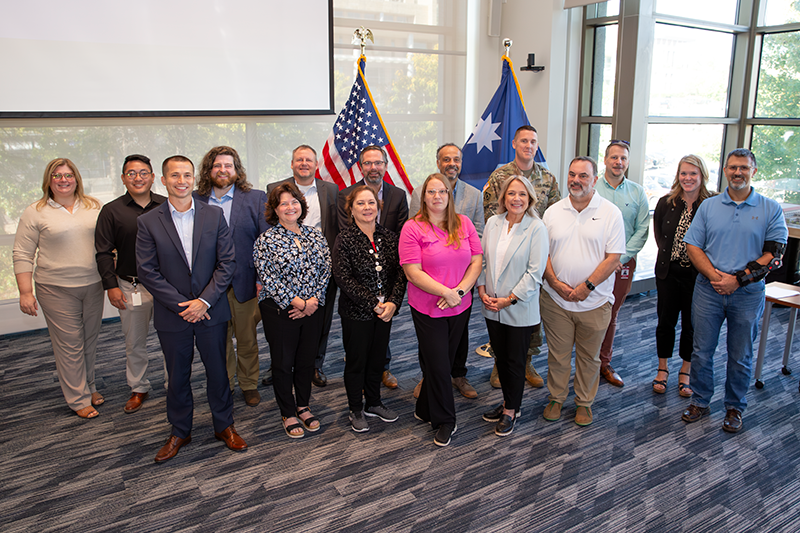
Back row L-R: Angela Hary, Foua Xiong, Tyler Christenson, John Israel, Jon Eichten, Tarek Tomes, Matt Harberts, Eric Shipman, Jodi Wroblewski.
